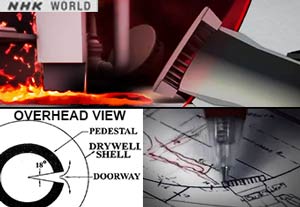
US gov’t analysis says Fukushima is more serious than ‘China Syndrome’ — Destroyed reactors suffered worst type of containment failure (PHOTOS)
ENE News
US Nuclear Regulatory Commission (NRC) on Early Releases (pdf): Generally, the most severe [containment] failure modes are ones that occur early in time (before or during reactor vessel failure) so that there is little settling or other retention of radionuclides in the containment… ruptures are more likely to lead to severe consequences… [T]he worst failures are failures that occur early and allow rapid, unscrubbed transit of radionuclides out of the containment…
NRC on Containment Failure Due to Drywell Shell Melt-through (pdf): There are two basic types of meltthrough to consider. First is the possibility of basemat meltthrough (the China Syndrome)… This failure mode is not generally catastrophic, because of the long time available for emergency response actions and the possibility of some retention in the soil. The second type of meltthrough is most applicable to Mark I BWR containments [All 3 Fukushima reactors used Mark I boiling water reactor containments]. In this case, molten material can exit the area beneath the reactor and flow across the floor, directly contacting the steel liner and causing it to fail. This type of failure… can happen much more quickly than basemat meltthrough and can lead to more serious consequences… A phenomenon of importance primarily for Mark I BWRs is shell (liner) meltthrough… The Mark I drywell floor area is small and the drywell shell is within ten feet of the pedestal doorway…
NRC on Containment Failure Due to Overpressure (pdf): Overpressure can theoretically lead to either leakage or large rupture… Steel containments are susceptible to rupture [if] the containment continues to pressurize. Given sufficient pressure, a crack in a steel containment can propagate catastrophically… a large rupture of the containment can lead to rapid transport of radionuclides to the environment with minimal retention.
NRC on Mark I BWR Containment Failure (pdf): [I]n general, Mark I containments are more likely to fail during a severe accident… However, the ranges of predicted failure probabilities are quite high for all BWR containment designs… BWR containment groups found a significant probability of early or late structural failure, given core damage.
Published: October 8th, 2014 at 8:35 am ETBy ENENews |
